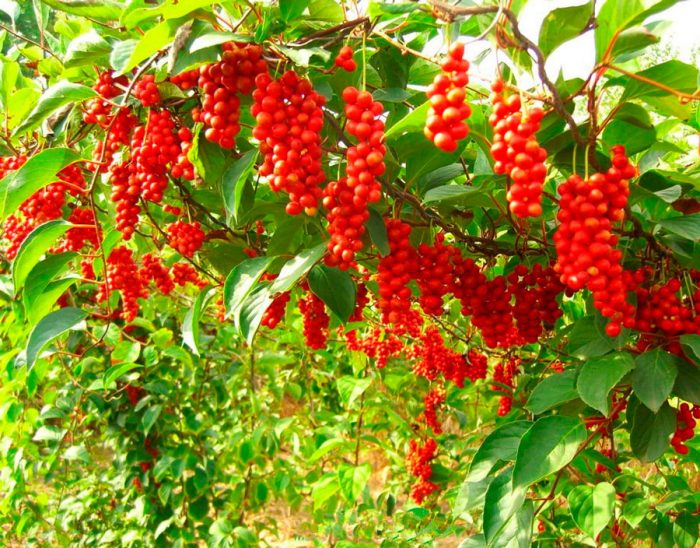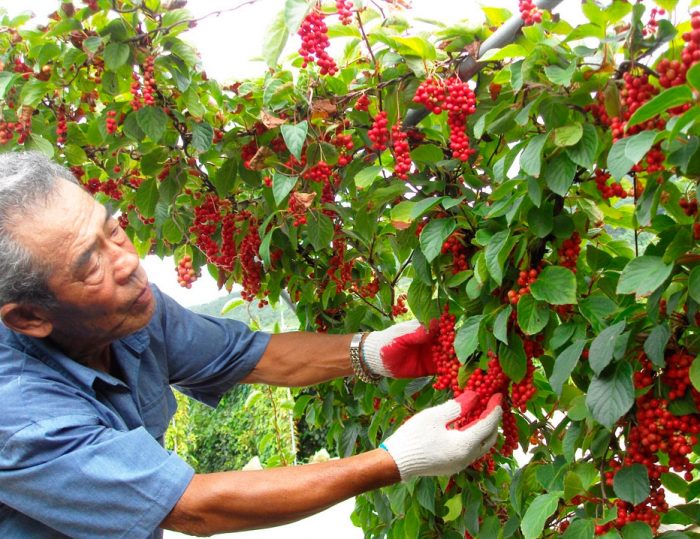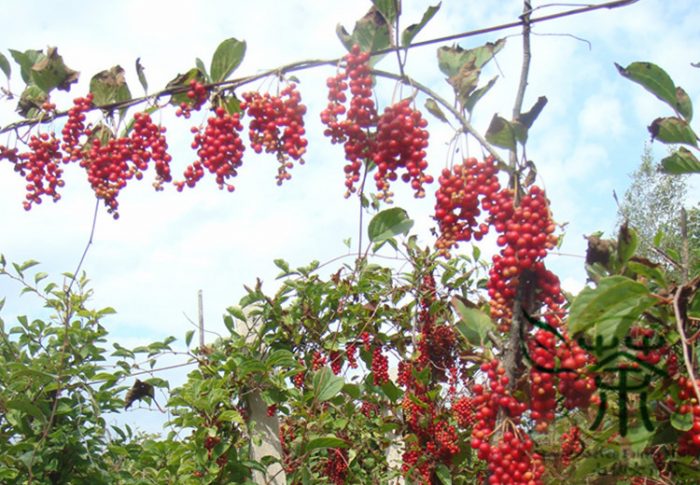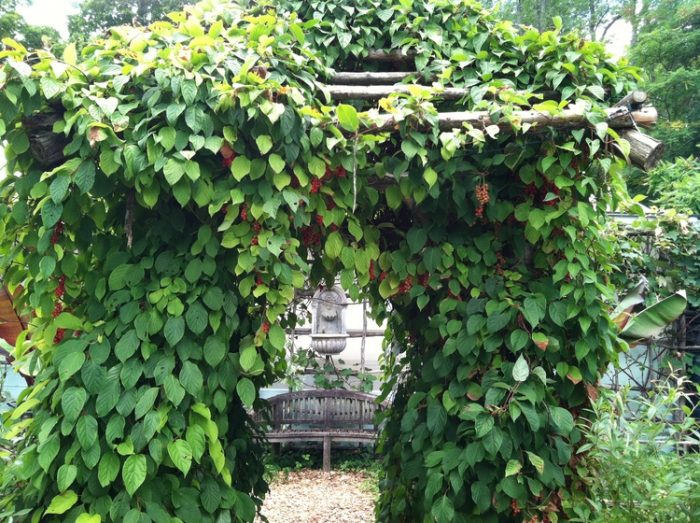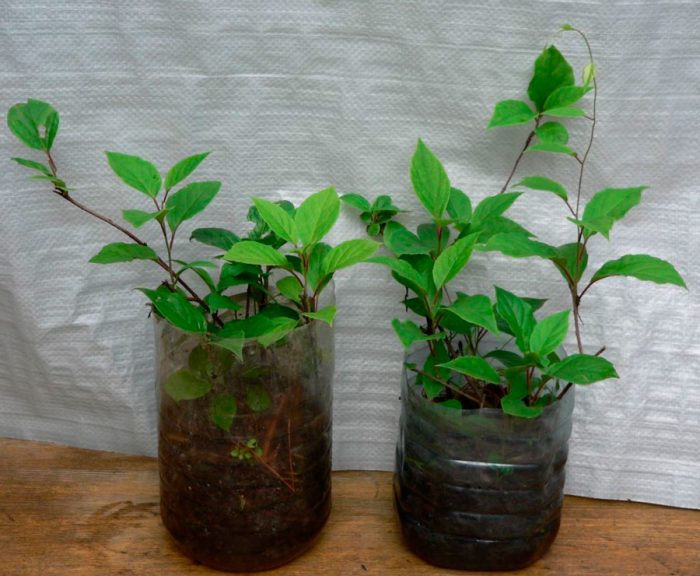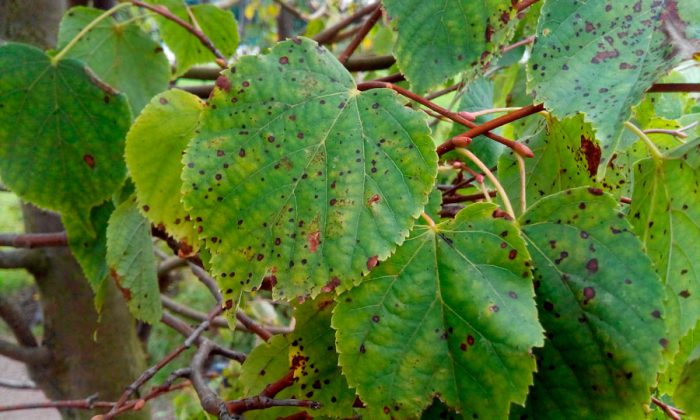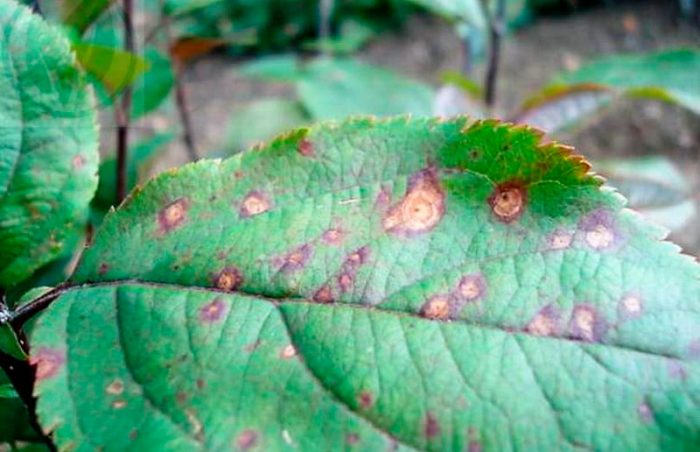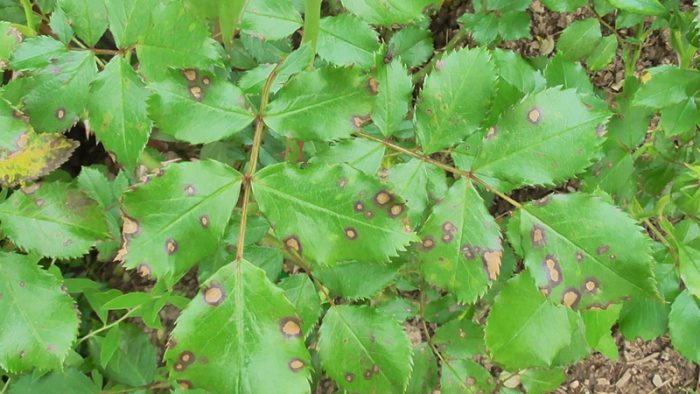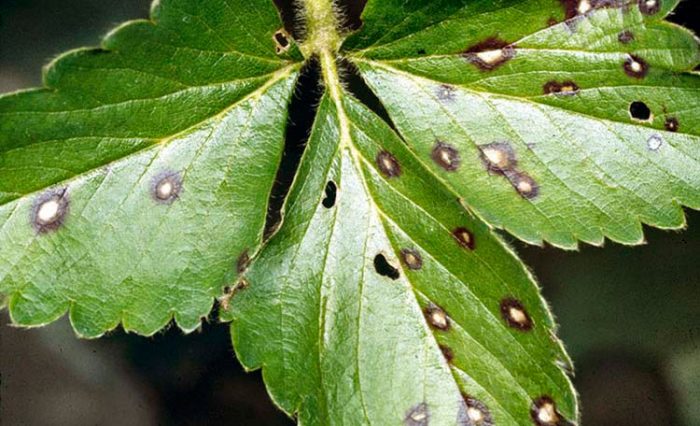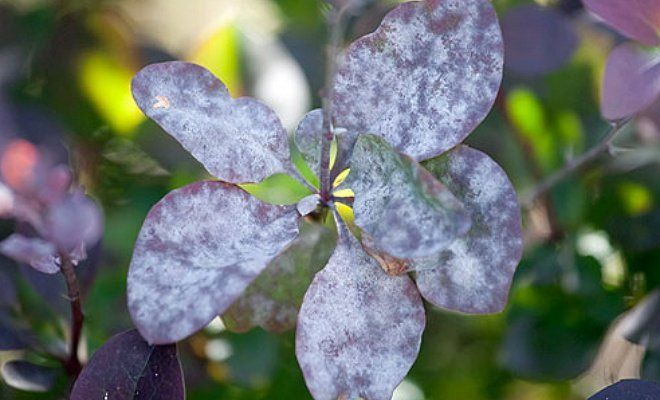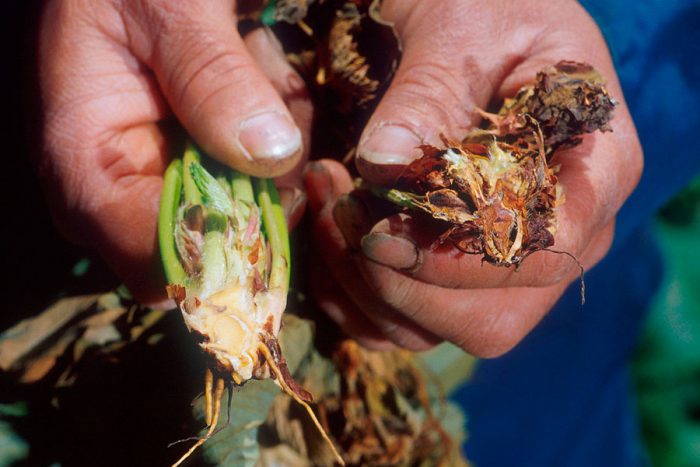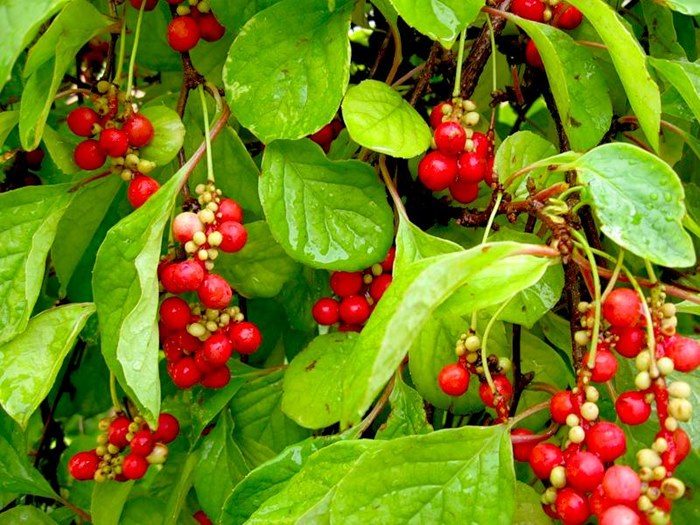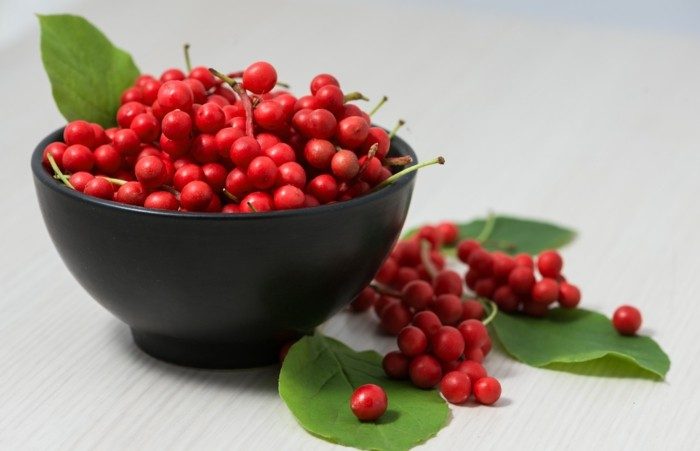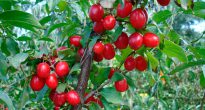Lemongrass (Schisandra) is a deciduous or evergreen plant belonging to the Schizandra family. According to information taken from various sources, this genus unites 14–23 species. Gardeners cultivate only Chinese Schisandra (Schisandra chinensis), which is also called medicinal lemongrass, or lemon tree. In nature, such a plant can be found in Korea, Sakhalin, in the Primorsky and Khabarovsk Territories of Russia, China, Japan, the Amur Region, as well as in the Kuril Islands. Today this wild liana is cultivated as a fruit tree.
Content
Features of lemongrass
Lemongrass is a deciduous vine, reaching a length of 10 to 15 meters. Its shoots curl along the support and reach 20 mm in diameter. The scaly bark of the stems is dark brown in color. The shoots are covered with a light yellow smooth bark. The length of dense leaf plates is about 10 centimeters, and the width is about 5 centimeters, they have a wedge-shaped base, a pointed tip, and an obscure toothed edge. Their front surface is naked, dark green in color, and the back is lighter and there is a slight pubescence on the veins. The leaves have petioles, reaching a length of 20-30 mm, they are painted red-pink. Foliage and shoots have a lemon scent. The dioecious flowers reach 15 mm in diameter, they also smell like lemon. After opening, the flowers are white, but over time they turn pink. They are located in the leaf axils on drooping pedicels. The fruit is a composite polyberry (multileaf), which has a racemose shape and is about 10 centimeters long. They include juicy red berries, inside which are the seeds of this plant. Lemongrass blooms in May-June, and the duration of its flowering is from 1.5 to 2 weeks. The fruits reach full maturity in September.
Schizandra fruits are used to make jams, jelly and soft drinks. They are also used in the confectionery industry, they are used to prepare fillings for sweets. Its juice is used to bunch wines, and aromatic tea is prepared from foliage and bark.Schisandra berries are used as medicinal raw materials.
Planting lemongrass in open ground
What time to plant
In regions with a mild climate, lemongrass is planted in open soil in October; in mid-latitudes, this procedure is recommended to be carried out in spring, or rather, in the last days of April or the first days of May. An area suitable for planting should be sunny and protected from cold winds. Experienced gardeners recommend planting at least three lemongrass bushes at once, while keeping a distance of 100 cm between them.When planting a plant near a building, at least 150 cm must be retreated from it, in this case, the water flowing from the roof will not fall on the root system of lemongrass.
Landing features
First you need to prepare a hole for planting. Its diameter can vary from 0.5 to 0.7 m, while the depth should be equal to 0.4 m. At the bottom of the pit, it is necessary to make a drainage layer of broken brick or crushed stone, while its thickness should be about 10 centimeters. After that, the pit should be covered with soil mixture, which includes turf soil, leaf compost and humus (1: 1: 1), 200 grams of superphosphate and 0.5 kg of wood ash should also be added to it. It will be possible to plant seedlings after half a month, during which time the soil in the pits will have time to compact and settle.
For planting, it is recommended to use two or three year old seedlings. At this time they reach a height of only 10-15 centimeters. Their root system is very well developed, so adaptation to a new place takes very little time. It should be noted that after the plant is planted, its root collar must be flush with the surface of the site. The soil in the near-trunk circle must be properly compacted. The planted plant needs abundant watering. Along the edge of the trunk circle, it is necessary to make a roller of ten-centimeter-high earth, thanks to which the water will not spread during watering. After the liquid is absorbed into the soil, the surface of the trunk circle will need to be covered with a layer of mulch (humus).


Watch this video on YouTube
Lemongrass care in the garden
Lemongrass saplings planted in open ground quickly take root, but at first they need protection from direct sunlight. It is very simple to care for such a plant, you need to water it on time, not very deeply loosen the surface of the trunk circle and remove weeds. During severe drought, the foliage of this plant must be sprayed with water. In a drought, an adult specimen also needs to ensure regular watering and spraying, while on average about 60 liters of water should be consumed per bush, which must be heated in the sun.
In the third year of growth, this vine begins to be fed. So, in April, 20–30 grams of saltpeter should be applied to the soil of the trunk circle, after which the plant will need abundant watering. When the liquid is absorbed into the soil, its surface must be covered with a layer of mulch (humus or sheet compost). In summer, every 15–20 days the plant should be fed with a solution of fermented mullein (1:10) or chicken droppings (1:20). In autumn, under each liana in the trunk circle, it is necessary to add 20 grams of superphosphate and 100 grams of wood ash, they are embedded to a depth of about 10 centimeters. Then the plant should be well watered.
Supports for lemongrass
To grow such a vine, you will need trellises. This method of placement will allow lemongrass to receive more sunlight, and this has an extremely positive effect on the size of the fruit. If it is grown without support, then it will be a small bush, while it will rarely bear fruit.The installation of the trellis is carried out in the same year as the planting of seedlings. To do it, you need to prepare the pillars, their height should be such that after they are buried in the ground by 60 centimeters, they would rise 200–250 centimeters above the surface of the site. A distance of 300 centimeters must be maintained between the posts. When they are installed, it is necessary to pull the wire on them in 3 rows: the first row should be done at a height of half a meter from the surface of the site, and the second and third - every 0.7-1 meter. While the bushes are young, they are tied to the lowest wire. As the stems grow, they need to be tied to the wires above.
If this liana is planted near the building, then in this case the trellis can be replaced by a ladder, which is installed obliquely.
Pruning lemongrass
The first pruning of this culture is carried out after 2 or 3 years have passed after planting in open soil. At this time, the rapid growth of the root system should slow down, and the aboveground organs, on the contrary, will begin to develop more rapidly. From the growing stems, you need to choose 3–6, and the rest should be cut out at ground level. As a rule, pruning is done in the fall, when all the foliage has fallen off. However, if the bush is very thickened, then this procedure is performed in June or July. In the winter or spring months, pruning is prohibited, since at this time of the year there is intense sap flow in the liana, so if you cut off the stems, this can lead to the drying out of the bush, which will cause it to die.
Schizandra will also need regular sanitary pruning, for this you need to cut out all dry, small, injured, disease-damaged or pest-damaged branches, as well as those that contribute to thickening. You also need to shorten the excessively long side shoots, while they should have no more than 10-12 buds.
Roots should be cut as needed throughout the season. To rejuvenate the vine, the stems, which are about 15-18 years old, must be gradually removed, while they should be replaced with a young root shoot.


Watch this video on YouTube
Transfer
This culture is extremely difficult to tolerate a transplant. At the same time, even a slight drying of the root system negatively affects the well-being of the plant. In this regard, experts do not recommend propagating lemongrass by dividing the bush. If you cannot do without a transplant, then thorough preparation should be made before digging out the plant. First, you need to dig a new planting hole and prepare the required amount of soil mixture. Only after that it will be possible to dig out the liana itself.
Reproduction of lemongrass
Such a plant can be propagated by seeds, rhizome suckers, cuttings and layering.
Growing from seeds
To grow lemongrass from seeds, it is recommended to sow before winter using freshly harvested fruits. They can also be sown in springtime. To do this, the seeds should be freed from the seedlings, then they are stratified for 8 weeks. The prepared seeds are sown in boxes filled with seedling soil mixture, while they are buried into the substrate only half a centimeter. Cover the containers on top with paper. You need to water the crops every day. The first seedlings should appear 7-15 days after sowing. They should be protected from direct sunlight. Crops are watered 1 or 2 times with a solution of potassium manganese of pinkish color. When the third or fourth true leaf plate begins to develop in the seedlings, it will be necessary to transplant them into larger boxes, while the distance between the plants should be about 50 mm. Planting in open ground should be done in the first summer weeks, but the seedlings must first be hardened within 15 days.The landing site must be shaded. During planting, a distance of at least 10 centimeters should be maintained between seedlings. So that the bushes do not suffer, in winter they will need to be covered with fallen leaves or spruce branches. These seedlings can be planted in a permanent place only after they are 2 or 3 years old.
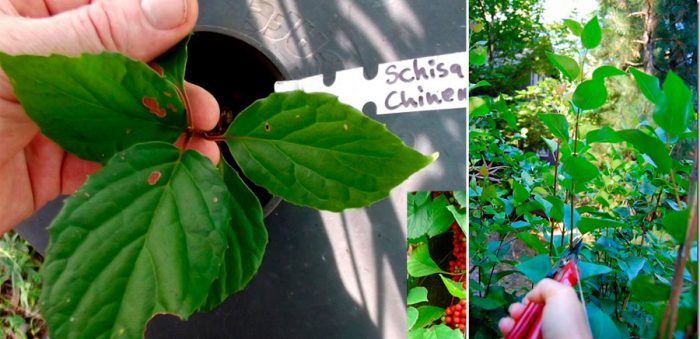
To harvest cuttings, use the tops of young stems. They are cut in the first days of July. Take a solution of Heteroauxin or Kornevin and dip the lower sections of the cuttings into it for a day. Then they are planted in moistened sand, the container is covered from above with a transparent glass cap or film.
Reproduction by branches
Powerful annual shoots of root growth are taken as layering. In April, before the sap flow begins, they must be bent to the surface of loose soil, then they must be fixed in this position and covered with a soil mixture consisting of humus and peat, the thickness of which should be from 10 to 15 centimeters. The upper part of the layer should be fixed to the trellis. The roots of the cuttings appear in the fourth or fifth month, and within two to three years an independent root system is formed. The cuttings can then be cut off from the mother plant and transplanted into a permanent location.
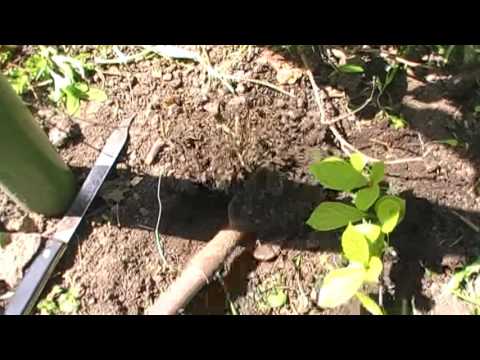

Watch this video on YouTube
Reproduction by root suckers
Reproduction by root suckers is carried out in the last days of April or the first in May. To do this, you should choose 2-4 offspring as distant as possible from the bush, they are dug up and immediately planted in pre-dug holes. They need to be transplanted very quickly, since even due to a slight drying of the root system, the plant may not take root in a new place. The transplanted offspring should be watered abundantly for four weeks, and they will also need protection from direct sunlight.
Schizandra pests and diseases
Not a single harmful insect settles on lemongrass, most likely this is due to the specific smell of this plant. He also has a fairly high resistance to diseases, but still sometimes such a vine gets sick.
Leaf spot
This crop can be affected by leaf spot. In infected specimens, blurry brown spots with black pycnidia dots appear on the underside of the leaf blades. This disease has one peculiarity, the fact that it can have a bacterial or fungal nature. To cure a liana, it must be sprayed with a preparation containing copper in its composition.
Phylostictosis
If large, almost black spots with purple edging appeared on the leaf plates, this means that the plant is infected with phyllostidosis of the leaves. In some cases, the affected tissue located in the center of the speck becomes colored and falls out, and a hole appears in its place. As a rule, only old foliage is affected by this disease. Treat the infected plant in the same way as in the case of spotting.
Ascochitosis
If lemongrass is infected with ascochitosis, then brown specks are formed on its surface, reaching 2 cm in size, while they have clearly pronounced zones. The diseased bush must be sprayed with a solution of Bordeaux mixture (1%).
Ramulariasis
Also lemongrass can get sick with a fungal disease such as ramulariasis. On the affected specimen, brown single specks are formed, angular or rounded, while their central part has a paler color, a pink bloom appears on it. A diseased plant must be treated with a fungicide.
Powdery mildew
When affected by powdery mildew, a loose bloom of whitish color appears on the surface of the shoots and leaf plates. Gradually the plaque becomes thick and brown. If the disease is at an initial stage, then you can get rid of it by treating the bush with soda ash.If the disease is started, then for spraying it will be necessary to use a preparation containing copper.
Fusarium
Seedlings of this plant are susceptible to fusarium. Because of it, a constriction (dark ring) is formed in the lower part of the stem. After some time, the shoot in this place becomes soft, which leads to the death of the plant. Infected plants must be pulled out, and the substrate must be spilled with a weak solution of potassium manganese.
Growing lemongrass in the Moscow region
Chinese lemongrass grows very well in the Moscow region. This crop is grown in Siberia and the Urals, as it has high frost resistance. Lemongrass is not afraid of any frost, especially if the bush is covered with a thick snowdrift. However, young plants must be covered for winter. To do this, they are covered with a thick (10-15 centimeters) layer of fallen leaves, on top of which spruce branches are thrown to scare off rodents. An adult liana does not need shelter for the winter.


Watch this video on YouTube
Types and varieties of lemongrass
Only 1 species is cultivated by gardeners - this is Far Eastern lemongrass or Chinese. This species has 2 varieties:
- Firstborn... A mid-season variety that is resistant to frost, pests and diseases. The cylindrical fruits consist of fragrant carmine-red fruits, reaching about 0.7 cm across and weighing 0.6 grams. The sour juicy pulp is colored deep red. The fruits are covered with a thin skin, if you press them down, then the juice will stand out quite easily.
- Sadovy-1... This variety is characterized by fast growth and high yield. One fruit grows about 25 sour, fragrant and very juicy fruits.
Lemongrass properties: harm and benefit
The healing properties of lemongrass
The composition of magnolia vine fruits contains organic acids (tartaric, malic and citric), sugars, coloring and tonic substances, vitamins C and E. The seeds contain fatty oil. The foliage contains macro- and microelements calcium, magnesium, manganese, copper, iron, zinc, cobalt, iodine and aluminum.
The biologically active substances schizandrol and schizandrin contained in lemongrass are of the greatest value. They stimulate the nervous and cardiovascular systems and improve liver function. The daily dose of these substances, which the body needs, is contained in 50 grams of fruit pulp.
Already in the 5th century BC, people knew that the Chinese lemongrass has a tonic and refreshing effect. That is why the hunters living in the Far East took the dried fruits of this plant with them. Today, these plants are used for mental or physical fatigue, depressive and asthenic syndromes as an adaptogenic and stimulating agent.
The seeds and berries of this vine in Chinese medicine are used to strengthen the heart, as well as for hypertension, anemia, sexual weakness, nephritis, heart neurosis, pulmonary tuberculosis and liver diseases. Decoction of fruits is used to stimulate tissue respiration, and also to lower blood sugar.
Lemongrass tincture is used for the prevention of acute respiratory infections and influenza, it helps to reduce the amount of glycogen in the liver, but there is an increase in its content in muscle tissues. To prepare the tincture, you need 20 grams of fruits and 10 grams of crushed seeds to combine with 100 milligrams of alcohol (70%). The vessel is tightly sealed and removed to a dark, cool place for 1.5 weeks for infusion. The tincture is filtered and drunk on an empty stomach, 25-30 drops each.
Such a plant is also used in the cosmetic industry. It is added to face masks with a toning effect.
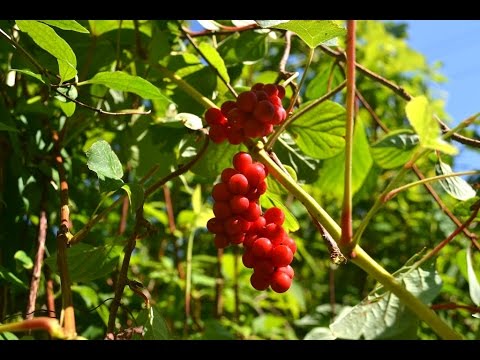

Watch this video on YouTube
Contraindications
Lemongrass, as well as products made on its basis, have practically no contraindications.Lemongrass should not be abused with increased acidity of the stomach, with high blood pressure, and also for people suffering from insomnia and easily excitable. Pregnant and breastfeeding women should consult a doctor before using lemongrass.

